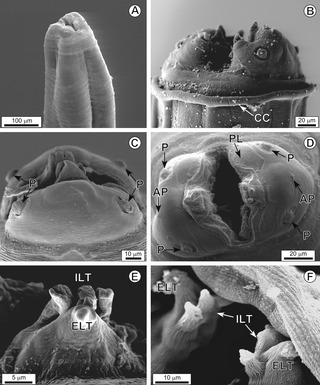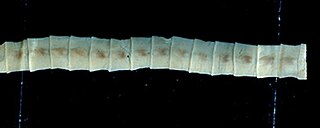
Helminthology is the study of parasitic worms (helminths). The field studies the taxonomy of helminths and their effects on their hosts.

The thorny-headed worm family Polymorphidae contains endoparasites which as adults feed mainly in fish and aquatic birds. When this taxon was erected by Meyer in 1931, a subfamily Polymorphinae was established in it. As the Polymorphidae as presently understood would then be monotypic, with no basal genera outside the Polymorphinae, the proposed subfamily is redundant for the time being and therefore most modern treatments simply omit it. Polymorphus minutus is an economically significant parasite in goose and duck farming.

Echinorhynchus is a genus of acanthocephalan parasitic worms. They parasitize a wide variety of fishes from both marine and fresh waters. The intermediate host is usually a crustacean.
Centrorhynchidae is a family of parasitic worms. Three species of these thorny-headed worms in the genus Centrorhynchus were found to parasitize birds of prey and owls Slovakia. These hosts include Buteo buteo, Buteo rufinus, Falco tinnunculus, Asio otus, Strix aluco, Strix uralensis and Tyto alba.
Polymorphus is a genus of parasitic worms from the phylum Acanthocephala. This group uses amphipod crustaceans as intermediate hosts and various birds as final hosts.
Stenurus is a genus of nematode that infects the respiratory system and sinuses of cetaceans, which includes whales, dolphins, and porpoises. Up to 1700 worms may be found in a single host.

Physalopteridae is a family of spirurian nematodes, which belongs to the superfamily Physalopteroidea. Like all nematodes, they have neither a circulatory nor a respiratory system.

Apatemon is a genus of flatworms belonging to the family Strigeidae.
Neodiplostomum is a genus of flatworms belonging to the family Diplostomidae.
Passalurus is a genus of nematodes belonging to the family Oxyuridae.

Bothriocephalus is a genus of flatworms belonging to the family Bothriocephalidae.
Rodentolepis is a genus of tapeworms belonging to the family Hymenolepididae.
Synhimantus is a genus of nematodes belonging to the family Acuariidae.
Falcaustra is a genus of nematodes belonging to the family Kathlaniidae.
Dichelyne is a genus of nematodes belonging to the family Cucullanidae.

Eucoleus is a genus of nematodes belonging to the family Capillariidae. Dwelling primarily in the airways of foxes, it can be found worldwide in dogs and cats.
Oxyuris is a genus of nematodes belonging to the family Oxyuridae.
Baruscapillaria is a genus of nematodes belonging to the family Capillariidae.
Proleptus is a genus of nematodes belonging to the family Physalopteridae.
Pseudocapillaria is a genus of nematodes belonging to the family Capillariidae.






